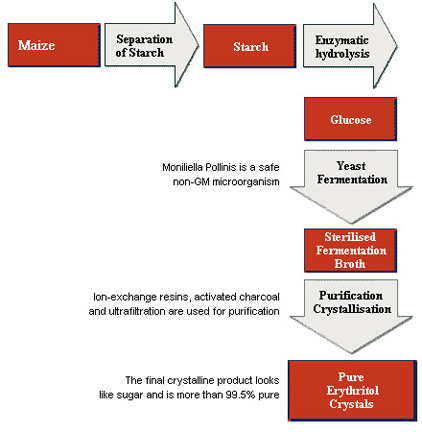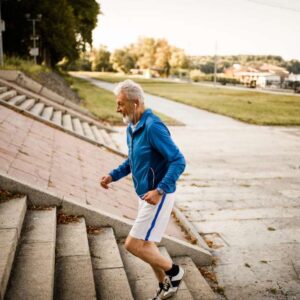
Stevia: A Sort-of-Natural FDA Approved Sweetener
- Isolate, synthesize, and add fillers for FDA approval
- There’s no sweet $70.4 million sales increase without a trademark
- The whole story on where to buy natural stevia
Dear Reader,
Last week’s Living Well Daily article about sweetened drinks really flooded the mail bag with reader responses.
Thanks so much for taking the time to drop me a line.
Also, my apologies if I haven’t replied to you yet — I will. It’s been a busy week over here. We have something very exciting lined up for you in the coming weeks.
Back to the mailbag…
Many of you wrote in to request an article about sugar-free sweetening options. Most requested were stevia and xylitol.
While some of you may have already heard of these or could be currently using them, there may be some shocking facts you don’t know about them.
So today, by popular demand, we will dive into the composition and best-buying practices of stevia sweeteners.
In a following article, I will get down to the nitty gritty on xylitol.
Thanks again for the article suggestions. Keep them coming! nmoore@lfb.org
Where’s the Real Stevia?
“Do you all have stevia?”
“Yes, we do. It’s in the green-and-white packages on the condiment bar.”
“Oh, that’s not real stevia. That’s synthetic sugar alcohols made from GMO corn.”
“Oh, yikes… I’m so sorry. It’s what our supplier gave us when we ordered stevia.”
To put this conversation in context, I did a stint as a barista while completing graduate school.
The coffee company I worked for is an organic and fair-trade business. So I felt like a heel as I explained to a customer that the only stevia available was not “real” stevia.
I shortly solved the condiment bar mystery when the operations manager told me we got the wrong sweetener from the supplier and the real stevia would be there in the morning.
At the time, I was too preoccupied with water quality research (part of my thesis project) to go down the not-so-natural stevia rabbit hole.
But these days, I am happy to investigate. I will share what I have found about the not real stevia at the coffee shop in a moment.
First, let’s talk about what real stevia is.
Stevia is a plant indigenous to Central and South America. The leaves contains a potent, nontoxic, and natural sweetener. In fact, stevia is up to 200 times sweeter than sugar.
But the best news about stevia — its calorie free.
This is great news if you are trying to cut out sugars.
Stevia’s sweetness comes from the combined effects of the natural compounds rebaudiosides and steviosides.1
Natural stevia, also called crude or whole-leaf, is available in a liquid or granular form. This makes stevia an easy solution for sweetening drinks and for cooking.
Crude or whole-leaf stevia is available in the U.S. as a dietary supplement but not as a food additive.
This means you can purchase it to add to your home-cooked meals or beverages, but it’s banned from processed or manufactured products.
Why?
The FDA has approved only the rebaudioside compound, also known as rebiana or reb A, for human consumption as a food additive.2
Natural Sweetener: FDA Style
So why would the FDA not allow whole-leaf stevia into processed foods? Here’s their reasoning:
“FDA does not consider their (crude and whole-leaf stevia) use in food to be GRAS (generally recognized as safe) in light of reports in the literature that raise concerns about the use of these substances. Among these concerns are control of blood sugar and effects on the reproductive, cardiovascular, and renal systems.”
Huh?
That’s weird…
The FDA has approved many synthetic sweeteners with questionable safety. Aspartame, saccharin, and sucralose, to name a few.
With the negative health effects of FDA-approved synthetic sweeteners being a hot research and news topic these days you would think they might take a closer look at a natural sweetener already in use as a food additive in many countries, including Japan.
Note: I scoured PubMed for an hour to find a study indicating that crude stevia could have negative health effects but didn’t find anything specific. It’s certainly possible I missed something. If you have any information regarding this, please forward it to me. nmoore@lfb.org
In 2008, food giants Cargill and PepsiCo were able to isolate reb A as the least bitter and sweetest compound in stevia. Shortly after, the FDA approved this stevia compound as a GRAS food additive.
But what if this isolation of reb A makes this natural sweetener less natural?
Herb pharm scientist Kevin Spelman, Ph.D., had this to say about it:
“Natural used to mean whole, as in holistic, but the concentrated extraction of one particular fraction of stevia that exists in the little green packet is a far reach from how stevia appears in nature.”4
In addition, Spelman questions the safety of the FDA-approved stevia. Plant chemistry is complicated. It is possible this “isolation” of reb A may have other consequences. He went on to comment:
“Once you extract a molecule from a plant, the plant’s safety profile changes. If you extract a single molecule from a plant, you are potentially bypassing the inherent safety mechanism that is typical of whole-plant extracts.”4
Yikes!
This raises other questions. If the commercial stevia in your food is an isolated compound, where is it coming from and what else might be in it?
1 Percent Chemically Engineered Stevia Extract
Since the approval of reb A, stevia products have been flying off shelves. Sales jumped from $2.1 million to $72.5 million in a three-year period.4
But most of the stevia products sold in stores contain only a fraction of stevia extract.
In fact, Truvia, a popular stevia product, contains 1 percent stevia extract. And this tiny fraction is the isolated and purified reb A. This way, Cargill can trademark the Truvia formula and continue to make money on it.
The main ingredient of the Truvia formula consist of erythritol, a sugar alcohol.
Like other sugar alcohols, erythritol exists naturally in small amounts in fruits. However, sugar alcohols are easily duplicated in labs.
In the case of Truvia’s erythritol — it’s chemically extracted from bioengineered corn and then purified to produce a crystal form.5

The erythritol manufacturing process Credit: Cargill Foods6
But Truvia isn’t the only not-so-natural offender.
Stevia In The Raw and PepsiCo’s Pure Via, other popular stevia products, also contain more than just stevia.
While there is no erythritol in Stevia in the Raw or Pure Via, there is dextrose and/or maltodextrin. These are bulking agents included to dilute the stevia’s sweetness and add volume to the formula.7
Dextrose and maltodextrin are corn-based carbohydrates. While they won’t keep Stevia In The Raw from being gluten-free, it is possible the corn it’s made from could be GMO.
In either case, staying clear of any additional lab-created or genetically modified ingredients is a good practice.
Natural Selections
In my opinion, keeping synthetics out of your is an important health decision.
Since food manufactures alter, synthesize, and manufacture their stevia products, whole-leaf stevia extract is the only natural choice for consumers.
Whole-leaf stevia is typically in the dietary supplement sections at stores and markets. Avoid all stevia products in the sweetener section as these are the chemically altered stevia selections.
Also, there is a large selection on Amazon.com. I recommend the SweetLeaf brand.
Whole-leaf stevia may have a more bitter or licorice-like flavor than its manufactured counterparts. Experimenting with different brands may help you find the most enjoyable selection for your palate.
Be sure to carefully read ingredients. If you aren’t familiar with a certain ingredient, research it.
And even though whole-leaf stevia is a natural sweetener, use it sparingly. As we have seen with other sweeteners, just because it’s non caloric doesn’t mean it can’t impact your health.
If you have a favorite stevia brand or anything else you would like to share, write me! nmoore@lfb.org
Live well,

Natalie Moore
Managing editor, Living Well Daily
P.S. There’s good news about stevia research. A study found consumption of stevioside, a stevia compound is connected to the cell death in breast cancer and decreases cancer-creating stress pathways in the body.8 Yay, stevia!
Sources
[2] Is Stevia an ‘FDA approved’ sweetener?
[3] Aspartame Associated with Increased Risk of Blood Cancers in Long-Term Human Study
[4] Stevia: Too Good to Be True?
[5] Lawsuit questions natural claims of Truvia
Written By Natalie Moore
Natalie Moore is a dedicated health researcher with a passion for finding healthy, natural, and science-based solutions. After a decade of direct healthcare experience in western and natural medicine, she was involved in public health research before joining Living Well Daily.
View More Free Articles
Stop Obsessing Over Diet Trends
Can we stop with the endless diet debates already? Every other week there’s a new headline shouting about which diet is best for weight loss, heart health, or diabetes. Paleo, keto, low-carb, high-protein… it’s exhausting. And now, a new meta-analysis is out comparing the Mediterranean diet, the DASH diet, and something called AHEI (that’s “Alternative...
A New Reason to Ditch Processed Junk
If you’ve ever walked the inside aisles of your local grocery store and thought, “This is all just junk,” your instincts were spot on. A new study published in the journal Thorax just added another red flag to the list of dangers linked to ultra-processed food—a 41 percent higher risk of lung cancer. That’s right....
When Being Winded on Stairs Is Serious (And When It Isn’t)
I had an athlete visit me recently because he experienced shortness of breath while climbing stairs. He is in great shape, so he was worried about what it might mean. “Doc,” he said, “I run five miles three times a week. Why am I huffing and puffing after two flights of stairs?” His concern is...
Study EXPOSES Hidden Danger Lurking in Your Car
We think of our homes and cars as safe havens. But according to a startling new study, they may be flooding your lungs with microscopic plastic particles—every single day. Researchers in France recently found that adults inhale an average of 68,000 microplastic particles daily from indoor air alone. To put that in perspective, that’s about...
Mailbag: Is Modern Food Making You Snore?
“What can cause snoring, and is there a way to correct this issue?” —Seeking Silence Hi Seeking, Snoring happens when the soft tissues in your throat relax and vibrate as air passes through during sleep. While several factors can cause snoring—from sleep position to nasal congestion—I want to share one trigger that might surprise you....
Simple Food Swap SLASHES Dementia Risk 28%
Let’s be honest… who would jump at the chance to cut their dementia risk by 28 percent. And no, you don’t need to run marathons, survive on broccoli, or learn to play the zither (whatever that is) to make it happen. All it takes is one easy swap—something that’s probably already in your refrigerator. Researchers...
This SMART Floss Exposes Hidden Health Danger
Scientists have created dental floss that doesn’t just clean between your teeth—it also tracks your stress while you’re flossing. Now, I know what you’re thinking… “Great—now even flossing is going to stress me out by telling me how stressed I am.” But this fascinating new tool from Tufts University could be a game-changer for understanding...
Is This "Safe" Sweetener Damaging Your Brain?
The headlines are alarming… “Popular Sugar Substitute Linked to Brain Cell Damage” and “Erythritol Could Damage Critical Brain Barrier” are just two of the dozens I’ve spotted recently. But before you toss every sugar-free product in your pantry, let’s take a closer look at what this study actually shows—and what it doesn’t. The latest research...
This Summer Threat Could SPIKE Your Blood Sugar
Picture this… It’s another scorching hot summer day. You crank up the air conditioning while watching the weather forecast, which predicts yet another “record-breaking” heat wave. It’s starting to feel like just another miserably uncomfortable summer. But what you might not realize is that—if you have diabetes—those rising temps could do far more damage to...
Move Over Yogurt—5 Foods That Pack MORE Probiotics
Let’s talk about your gut. The microbiome is the collection of trillions of bacteria and other tiny organisms that live in and on your body—especially in your gut—and help keep you healthy. I’ve written often about how vital it is to maintain a healthy microbiome. And you might have dutifully added yogurt to your shopping...









